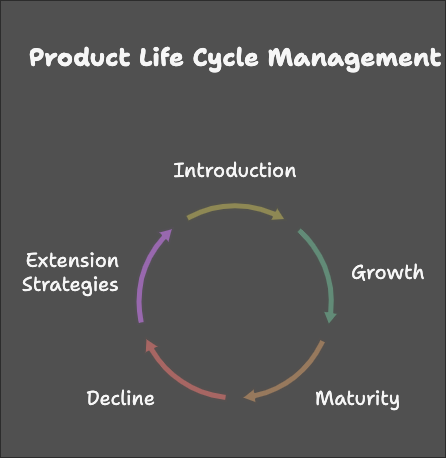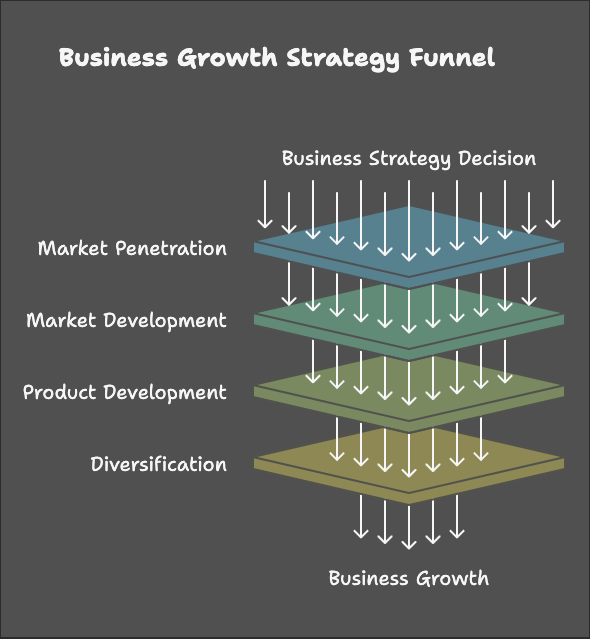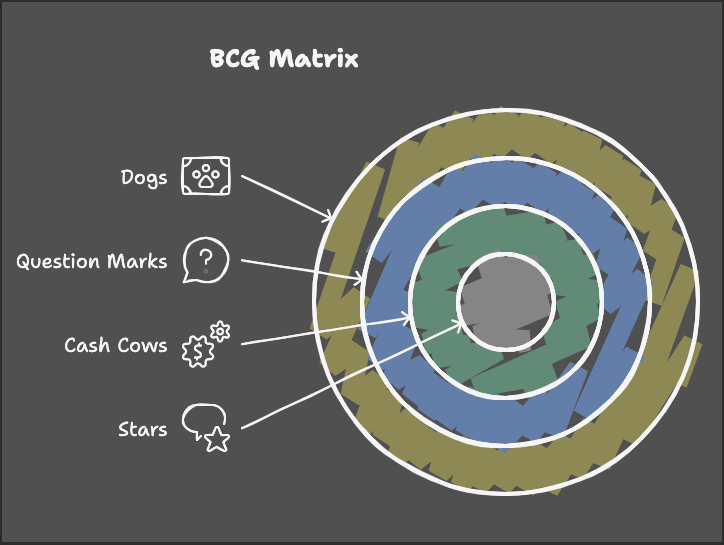Product Life Cycle
Product Life Cycle Strategies
Product Life Cycle (PLC) Strategy
Products,The likeProduct people,Life goCycle (PLC) describes the stages a product goes through differentfrom stagesits launch to its eventual decline in life:the market. Each stage requires different marketing, pricing, and product strategies.
-
Introduction:Definition:TheThis is when the product is launchedandinsalesthe market. Sales areslowlow,asandcustomersthearecompanyjustinvestslearningheavilyaboutinit.promotion and distribution to create awareness. -
Growth:Characteristics:- High costs due to product development and marketing.
- Low or negative profits.
- Customers are early adopters and innovators.
-
Strategies:
- Promotion: Aggressively promote to build awareness (e.g., advertising, social media campaigns).
- Pricing: Use penetration pricing (low prices to gain market share) or skimming pricing (high prices to recover costs).
- Distribution: Focus on building distribution channels.
- Definition: The product gains acceptance, sales increase rapidly, and profits improve.
-
Characteristics:
- Increasing demand and sales volume.
- Growing market share and profitability.
- Competitors may enter the market.
-
Strategies:
- Product Development: Enhance product features and quality.
- Market Expansion: Target new customer segments or geographic regions.
- Promotion: Shift focus from awareness to differentiation.
- Pricing: Consider competitive pricing to defend market share.
- Definition: The market becomes saturated, and growth slows down. Profits peak and then stabilize or decline.
-
Characteristics:
- Intense competition and price wars.
- Customer demand stabilizes.
- Focus shifts to retaining customers.
-
Strategies:
- Differentiation: Add unique features to stand out.
- Promotions: Run loyalty programs, discounts, and bundling offers.
- Market Penetration: Attract competitors’ customers or non-users.
- Cost Management: Optimize production and distribution to maintain profitability.
-
Definition: Sales
startand profits decline as customer interest fades due toincreasenewrapidlyinnovationsasor changes in consumer preferences. -
Characteristics:
- Shrinking market size.
- Reduced profitability or losses.
- Obsolescence or market saturation.
-
Strategies:
-
Product Updates: Relaunch or reposition the product
gainsifpopularity.possible. -
Maturity:Cost Control:SalesMinimizegrowthcostsslowsbydownreducingasmarketingtheandmarketdistributionbecomes saturated.efforts. -
Decline:Harvest Strategy:SalesFocusdeclineonasprofitability over sales by targeting niche markets. -
Exit Strategy: Discontinue or sell the product
becomesifoutdateditoris no longer viable.
-
Product Updates: Relaunch or reposition the product
-
Product Modification: Update or improve product features, design, or packaging.
- Example: Adding advanced features to smartphones, like foldable screens.
-
Rebranding or Repositioning: Change the way the product is perceived by targeting a new market or emphasizing different benefits.
- Example: Baking soda repositioned as a cleaning agent instead of just a baking ingredient.
-
Geographic Expansion: Enter new markets or regions.
- Example: Expanding sales of a product from domestic markets to international ones.
-
Promotional Efforts: Increase advertising, launch new campaigns, or offer discounts to reignite interest.
- Example: Limited-time offers or seasonal promotions.
-
Target New Segments: Identify and target untapped customer groups.
- Example: Marketing energy drinks to older adults as a health supplement.
-
Introduce Variants: Launch new variants, such as flavors, sizes, or special editions.
- Example: Coca-Cola introducing sugar-free or flavored versions of its drinks.
- Market Adaptation: Helps businesses adapt their strategies to the changing needs of the market.
- Resource Allocation: Guides investments in marketing, R&D, and production.
- Competitive Advantage: Enables firms to stay competitive by modifying their strategies based on the product's stage.
- Profit Maximization: Helps companies capitalize on high-demand phases and minimize losses during decline.
Finding new uses for the product:Think baking soda, which is used for baking, cleaning, and deodorizing.Attracting new users:Targeting new customer segments.Increasing usage among existing customers:Encouraging customers to use the product more often.Relaunching the product with new features or improvements:Giving the product a fresh look or updated functionality.-
Market Penetration:Definition: Selling more of thesameexisting products toexistingthecustomers.current markets. - Objective: Increase market share.
-
Strategies:
- Increase advertising and promotional efforts.
- Introduce loyalty programs or discounts.
- Improve distribution to increase product availability.
- Example: Coca-Cola encouraging increased consumption through discounts and marketing campaigns.
-
Definition: Selling existing products
Sellingto new markets. - Objective: Expand customer base by targeting new geographic regions or new customer segments.
-
Strategies:
- Expand into international markets.
- Target a different demographic or industry.
- Adapt existing products to
new customers. Product Development:Developing new products for existing customers.Diversification:Developing new products forsuit new markets.
- Example: McDonald's entering new countries and adapting menus to local tastes.
- Definition: Introducing new products to existing markets.
- Objective: Increase sales by meeting new customer needs.
-
Strategies:
- Invest in research and development (R&D).
- Add new features to current products.
- Develop complementary products.
- Example: Apple launching a new iPhone model to target its existing customer base.
- Definition: Introducing new products to new markets.
- Objective: Enter completely new areas to spread risk and increase revenue.
-
Types of Diversification:
- Related Diversification: New products related to existing offerings (e.g., a car company launching electric vehicles).
- Unrelated Diversification: Entering an entirely different industry (e.g., a food company starting a financial services division).
- Example: Amazon moving from online retail to cloud computing (AWS).
- Definition: Products or business units with high market growth and high market share.
-
Characteristics:
- Require significant investment to maintain growth.
- Have the potential to become cash cows.
-
Strategy:
- Invest to sustain growth and maintain leadership.
- Example: A fast-growing product like Tesla's electric vehicles in the EV market.
- Definition: Products with low market growth but high market share.
-
Characteristics:
- Generate consistent cash flow with minimal investment.
- Often used to fund other ventures (e.g., Stars or Question Marks).
-
Strategy:
- Maintain and defend market share.
- Example: Coca-Cola’s flagship beverages in the soft drink market.
- Definition: Products with high market growth but low market share.
-
Characteristics:
- Have potential to become Stars but require significant investment.
- Risk of failure if not supported properly.
-
Strategy:
- Assess and invest in promising opportunities or divest if growth seems unlikely.
- Example: New startups or product lines in emerging markets.
- Definition: Products with low market growth and low market share.
-
Characteristics:
- Generate little profit and often require significant resources.
- May be phased out or sold off.
-
Strategy:
- Harvest (minimize investment and maximize cash flow) or divest.
- Example: Outdated technologies like DVD players.
-
Stars:Ansoff’s MatrixHighhelpsmarketbusinessesshare, highexplore growthpotential.opportunities. -
CashBCGCows:MatrixHighhelpsmarketallocateshare,resourceslowtogrowthproductspotential.or - business
QuestionunitsMarks:Low market share, high growth potential. Dogs:Low market share, low growth potential.effectively.
Stages of the Product Life Cycle
1. Introduction Stage
Example: Electric vehicles like Tesla's early models.
2. Growth Stage
Example: Smartphones with advanced features entering the mainstream market.
3. Maturity Stage
Example: Carbonated soft drinks like Coca-Cola, which have been in the maturity stage for decades.
4. Decline Stage
Example: DVD players replaced by newerstreaming alternatives.services.
Strategies to Extend the Product Life Cycle
To prevent products from reaching the decline stage, companies can adopt the following extension strategies:
Importance of PLC Strategies
Visual Representation of the PLC
CompaniesHere’s usea differentbasic outline of the product life cycle curve:
| Stage | Sales | Profits | Key Focus |
|---|---|---|---|
| Introduction | Low | Negative/Low | Awareness and adoption. |
| Growth | Rapid growth | Increasing | Market penetration. |
| Maturity | Peak sales | Peak profits | Customer retention. |
| Decline | Declining | Decreasing | Cost reduction or exit. |
By understanding the product life cycle and adopting appropriate strategies at each stagestage, tobusinesses can optimize their product's performance, maximize success.profits, Forand example,extend its longevity in the introduction stage, they focus on creating awareness, while in the maturity stage, they might focus on defending market share.market.
Product Life Cycle Extension
To keep products thriving, companies can use strategies like:
Strategic Tools
Ansoff's Matrix
Ansoff's Matrix
ThisThe Ansoff Matrix, also known as the Product/Market Expansion Grid, is a strategic planning tool that helps businesses decide onidentify growth strategiesopportunities by consideringfocusing new or existingon products and markets.
Four Growth Strategies in Ansoff’s Matrix
1. Market Penetration
2. Market Development:Development
3. Product Development
4. Diversification
| Strategy | Products | Markets | Risk Level |
|---|---|---|---|
| Market Penetration | Existing | Existing | Low |
| Market Development | Existing | New | Moderate |
| Product Development | New | Existing | Moderate |
| Diversification | New | New | High |
BCG Matrix (Boston Consulting Group Matrix)
The BCG Matrix is a portfolio management tool that helps businesses evaluate the performance of their products or business units based on market growth rate and relative market share.
This
Components helpsof businessesthe analyzeBCG theirMatrix
1. portfolioStars
2. Cash Cows
3. Question Marks
4. Dogs
| Category | Market Growth | Market Share | Strategy |
|---|---|---|---|
| Stars | High | High | Invest and sustain growth. |
| Cash Cows | Low | High | Maximize cash flow and maintain. |
| Question Marks | High | Low | Invest selectively or divest. |
| Dogs | Low | Low | Harvest or phase out. |
Comparison of Ansoff Matrix and BCG Matrix
| Aspect | Ansoff Matrix | BCG Matrix |
|---|---|---|
| Purpose | Identifies growth opportunities. | Assesses product performance and profitability. |
| Focus | Product and market |
Market growth and market share. |
| Scope | Forward-looking (strategy planning). | Current portfolio analysis. |
| Use Case | Developing growth plans. | Allocating resources to product lines. |
Conclusion
Both Ansoff’s Matrix and BCG Matrix are essential tools in strategic planning:
These tools are often used together to ensure a balanced approach to growth and profitability. Let me know if you need further elaboration! .



